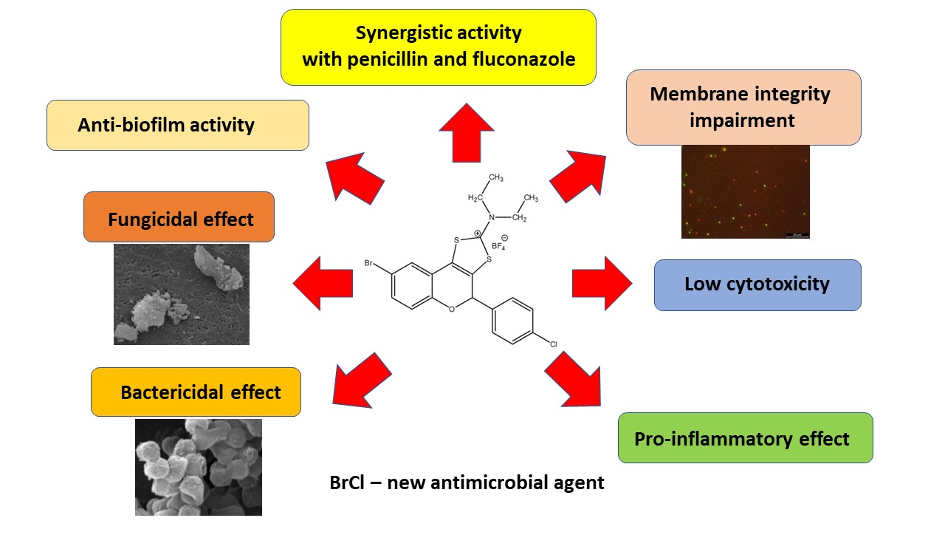Tricyclic
1,3-dithiolium flavonoids - New weapons to combat antibiotic
resistance
(TriSflav)
PN-III-P2-2.1-PED-2019-2235,
NR. 550PED ⁄ 2020
- Research project funded by the Ministry of Education and Scientific Research - Executive Unit for Financing Higher Education, Research, Development and Innovation (UEFISCDI), PNCDI III - P2 - Increasing the competitiveness of the Romanian economy through RDI, Subprogramme 2.1 - Competitiveness through research, development and innovation).
- Funding
amount - 600.000 lei (approx. 122,450
euro);
- Funding period - 24 months (26.10.2020 - 15.11.2022).
Project summary:
The
discovery of penicillin followed by the use of antibiotics
for the therapy of infectious diseases since the 1940s
represented one of the most important moments in the
evolution of modern medicine. However, a good number of
pathogens have developed resistance to antibiotics, raising
serious doubts about their efficiency in use. At present,
antibiotic resistance of pathogenic microorganisms is a
major concern of mankind, posing a serious threat to human
health and economic development worldwide. The alarming
spread of resistance along with the reduction of new
developed antibiotics significantly decreased therapeutic
possibilities, leading to increased mortality and morbidity.
Finding effective new molecules to keep pace with antibiotic
resistance is an important goal of current biomedical
research.
In this context, the TriSflav project aimed to validate
tricyclic synthetic flavonoids as effective antimicrobial
agents. During the project, four flavonoids having I, Br, Cl
and F as halogenated substituents at the benzopyran core
were synthesized and characterized. The synthetic flavonoids
were tested against bacterial (Staphylococcus aureus,
Streptococcus pneumoniae, Acinetobacter baumannii,
Enterococcus faecium and Escherichia coli,
etc.) and fungal (Candida albicans, C. krusei
and C. parapsilosis) clinically isolated strains,
with different antibiotic resistance profiles. The obtained
results showed that the tested synthetic flavonoids have
important bactericidal and fungicidal properties, the
antimicrobial activity being more important compared to
antimicrobials such as penicillin, gentamicin or
fluconazole. Antimicrobial effects are due to the fact that
flavonoids target the cytoplasmic membrane, affecting its
integrity and causing cell death. Furthermore, the proposed
flavonoids influence some factors involved in antibiotic
resistance or virulence. Thus, they show an important
anti-biofilm activity, inhibiting the formation of biofilms
or destroying mature microbial biofilms at low
concentrations. The synthetic flavonoids have a reduced
cytotoxicity at concentrations lower than 13.16 µg/ml and
possess a pro-inflammatory effect.
Finally, the project proposed the flavonoid BrCl as an
antimicrobial agent, with potential practical applications
as an antibiotic and antiseptic (against some resistant
strains of S. aureus, S. pneumoniae, A.
baumannii and E. coli); disinfectant, against
a wide spectrum of pathogenic microorganisms (including
ESKAPE group pathogens and Candida species)
resistant to antibiotics/antifungals.

Team |
Research |
Results |
Background
The desperate need for new antimicrobials. The discovery of penicillin in the 1940s was a turning point in human history, revolutionizing medicine and saving countless lives (Davies and Davies 2010). However, the discovery of efficient antibiotics provided a false sense of security to humankind due to the emergence of multidrug resistant bacteria (MDR) very soon after. Increasing resistance of microbial pathogens against many available antibiotics is a medical problem of major concern all over the world (Orhan et al. 2010). The discovery of new and more efficient antimicrobial drugs is therefore a matter of high priority among scientists and clinicians worldwide. Ideally, antibacterial agents should belong to new classes, since the structural alteration of drugs to which resistance has already developed, rarely provides a major solution (Cushnie and Lamb 2011).
Flavonoids as antimicrobials. Flavonoids, a group of heterocyclic organic compounds present in plants and related products, are a source of potentially good candidates for developing antimicrobial agents. Flavonoids have been used for a long time to treat and prevent various infectious diseases such as respiratory, gastrointestinal, urinary and skin infections (Seleem et al. 2017). In the past few years the subject of antibacterial research was focused on semisynthetic and synthetic flavonoids, some of these compounds being more active than the natural flavonoids.
Tricyclic 1,3-dithiolium flavonoids - new weapons to fight AMR. Our research group synthetized and characterized several novel tricyclic 1,3-dithiolium flavonoids (TSFl) with completely new structures, unrelated to any known natural compound (Bahrin et al. 2012). After an initial evaluation, we successfully demonstrated that these compounds displayed very potent antibacterial properties, inhibiting and also killing bacterial cells at very low concentrations (Lungu et al. 2013; Bahrin et al. 2014; Babii et al. 2016; Bahrin et al. 2016; Babii et al. 2018). One compound in particular – 4b (Figure 1), a TSFl with a bromine substituent at the benzopyran core (TSBrFl), displayed very potent antibacterial properties with low MIC values, as our preliminary results showed: 0.24 μg/ml against Staphylococcus aureus and 3.9 μg/ml against Escherichia coli (Babii et al. 2016).

1. Synthesis and characterization of new flavonoids using the compound 4b scaffold.
2. Optimization of flavonoids 4a-d synthesis using a one-pot synthesis and a large-scale procedure – a necessary step to prepare a strategy for the technological transfer.
3. Evaluating the flavonoids 4a-d antimicrobial spectrum and understanding the mechanism of action.
4. Assessing the shelf-life, solubility and cytotoxicity of the new compounds.
5. Disseminating the results to the academia and industry in the form of conference presentations/workshops, papers.
Contact
Project manager:
Marius Ștefan, PhD
E-mail: stefanm@uaic.ro
Phone: 40(0)232201102 - 1524
Fax: 40(0)232201472
Further details: here
